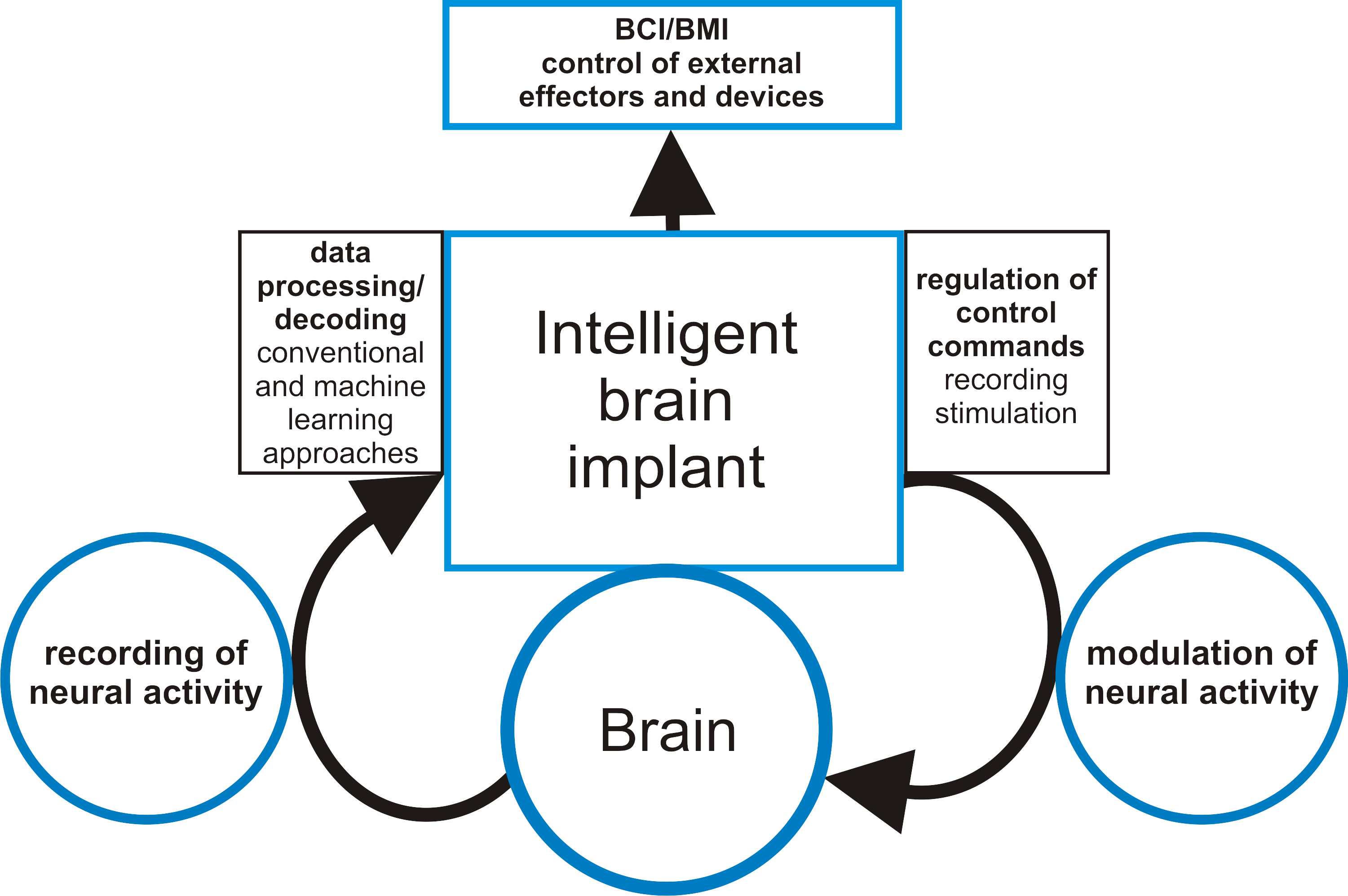Intelligent Brain Implants
Affiliated researchers: PD Dr. Tonio Ball, Alexis Gkogkidis
Intelligent neuromedical implants capable of recording and electrical stimulation of the brain have become an important branch of neurotechnology and clinical therapeutic applications. The use of electrical stimulation reaches from deep structures of the brain (deep brain stimulation or short DBS) as used in patients suffering from Parkinson’s disease or depression, to intracortical electrode arrays (e.g. the quite established, so called Utah Array) whose electrode tips reach to deeper layers of the cerebral cortex, to electrocorticographic (ECoG) electrode arrays, which are positioned on the surface of the cerebral cortex, to finally non-invasive stimulation methods using surface electroencephalographic (EEG) electrodes or methods where special transcranial current electrodes are used.
Our interdisciplinary research group focuses on electrical stimulation using the miniaturized version of ECoG electrode arrays, the so called micro-ECoG in combination with intelligent implantable devices, both developed in collaboration with Prof. Stieglitz (IMTEK Freiburg) and the CorTec GmbH. In this branch of our group it is the aim to use neural implants to record activity from the brain and use open- and closed-loop direct cortical electrical stimulation to investigate stimulation-specific modulations of brain activity.
Our aims are:
· The investigation of stimulation-dependent brain activity changes like so called cortico-cortical evoked potentials (CCEPs), which can be elicited by single pulse electrical stimulation. CCEPs are a direct indication for connections between areas where the stimulation was applied and where the potentials were measured.
· Expansion of the single pulse approach: Investigation of a broad spectrum of stimulation frequencies instead of single pulses in an open- and closed-loop stimulation setting to investigate not only cortico-cortical evoked potentials but cortico-cortico spectral changes, i.e. changes in different frequency bands, which are known to be the neural correlate of biological and behavioral patterns.
· Incorporation of state-of-the art machine learning approaches (deep neural networks, convolutional neural networks, etc.) to the stimulation paradigms enabling intelligent closed-loop stimulation control.
Schematic illustration of an intelligent neuromedical implant loop. Neural data input is acquired by electrophysiological measurement methods and forwarded to the implants’ processing unit. The outcome of the analysis and decoding of neural data controls the output of the intelligent implant for both modulation of brain activity via direct cortical electrical stimulation and/or BCI/BMI applications.
Intelligent neuromedical implants are suitable devices for the combination of recording of brain activity and the utilization of electrical brain stimulation on the road to pre-clinical and clinical applications and will have immense impact on neurotechnological research and the medical applications of tomorrow in the treatment neuropsychological disorders and the utilization of brain-computer and brain-machine interfaces (BCIs/BMIs).


Prototypes of intelligent neural implants developed within BrainLinks-BrainTools for closed-loop applications of electrical stimulation.
Further reading and references:
Gkogkidis, C. Alexis, Xi Wang, Tobias Schubert, Mortimer Gierthmühlen, Fabian Kohler, Andreas Schulze-Bonhage, Wolfram Burgard, et al. 2017. “Closed-Loop Interaction with the Cerebral Cortex Using a Novel Micro-ECoG-Based Implant: The Impact of Beta vs. Gamma Stimulation Frequencies on Cortico-Cortical Spectral Responses.” Brain-Computer Interfaces 4(4): 214–24. https://doi.org/10.1080/2326263X.2017.1381829.
Gkogkidis, C.A., C.Bentler, X.Wang, M.Gierthmuehlen, C.Scheiwe, H.Cristina Schmitz, J.Haberstroh, T.Stieglitz, T. Ball, “Neurophysiological Evaluation of a Customizable μECoG-based Wireless Brain Implant”, 40th International Conference of the IEEE Engineering in Medicine and Biology Society, 2018, 10.1109/EMBC.2018.8513044
Kohler, F., Gkogkidis, C.A., Bentler, C., Wang, X., Gierthmuehlen, M., Fischer, J., Stolle, C., et al. 2017. “Closed-Loop Interaction with the Cerebral Cortex: A Review of Wireless Implant Technology.” Brain-Computer Interfaces 0 (0): 1–9. https://doi.org/10.1080/2326263X.2017.1338011.
Wang, Xi, C. Alexis Gkogkidis, Olga Iljina, Lukas D. J. Fiederer, Christian Henle, Irina Mader, Jan Kaminsky, Thomas Stieglitz, Mortimer Gierthmuehlen, and Tonio Ball. 2017. “Mapping the Fine Structure of Cortical Activity with Different Micro-ECoG Electrode Array Geometries.” Journal of Neural Engineering 14 (5): 056004. https://doi.org/10.1088/1741-2552/aa785e.
Wang, X., Gkogkidis, C.A., Schirrmeister, R., Heilmeyer, F.A., Gierthmuehlen, M., Kohler, F., Schuettler, M., Stieglitz, T., Ball, T., „Deep Learning for micro-Electrocorticograpic (µECoG) Data”, 2018 IEEE EMBS Conference on Biomedical Engineering and Sciences (IECEBS), arXiv preprint arXiv:1810.02584.
Gierthmuehlen, Mortimer, Xi Wang, Alexis Gkogkidis, Christian Henle, Joerg Fischer, Thomas Fehrenbacher, Fabian Kohler, et al. 2014. “Mapping of Sheep Sensory Cortex with a Novel Microelectrocorticography Grid.” Journal of Comparative Neurology 522 (16): 3590–3608. https://doi.org/10.1002/cne.23631.
Casimo, Kaitlyn, Lila H. Levinson, Stavros Zanos, C. Alexis Gkogkidis, Tonio Ball, Eberhard Fetz, Kurt E. Weaver, and Jeffrey G. Ojemann. 2017. “An Interspecies Comparative Study of Invasive Electrophysiological Functional Connectivity.” Brain and Behavior, November. https://doi.org/10.1002/brb3.863.

